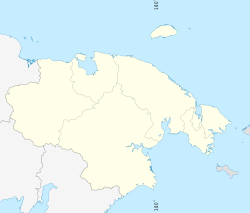Egvekinot
| Egvekinot (English) Эгвекинот (Russian) Ирвыкыннот (Chukchi) |
|
|---|---|
| - Urban-type settlement - | |
 Double rainbow over Egvekinot |
|
 Location of Chukotka Autonomous Okrug in Russia |
|
|
|
|
|
|
|
| Administrative status (as of June 2012) | |
| Country | Russia |
| Federal subject | Chukotka Autonomous Okrug |
| Administrative district | Iultinsky District |
| Administrative center of | Iultinsky District |
| Municipal status (as of October 2010) | |
| Municipal district | Iultinsky Municipal District |
| Urban settlement | Egvekinot Urban Settlement |
| Administrative center of | Iultinsky Municipal District, Egvekinot Urban settlement |
| Head | Alexey Geraskin |
| Statistics | |
| Population (2010 Census) | 2,790 inhabitants |
| Population (January 2016 est.) | 2,815 inhabitants |
| Time zone | PETT (UTC+12:00) |
| Founded | 1946 |
| Postal code(s) | 689201, 689202 |
| Dialing code(s) | +7 42734 |
Egvekinot (Russian: Эгвекино́т; Chukchi: Ирвыкыннот, lit. sharp, hard land) is an urban locality (an urban-type settlement) and the administrative center of Iultinsky District in Chukotka Autonomous Okrug, Russia. Population: 2,790 (2010 Census);2,413 (2002 Census);5,478 (1989 Census).
Egvekinot, located on the coast of Kresta Bay (a part of the Bering Sea) at the foot of mountains some 800 meters (2,600 ft) high, is a port settlement with a maximum depth of 35 meters (115 ft). It is located 1,675 kilometers (1,041 mi) from Magadan, 236 kilometers (147 mi) from Anadyr, and 6,097 kilometers (3,789 mi) from Moscow.
Archeological excavations around the settlement have indicated that the area was inhabited in Neolithic times and possibly even in the Mesolithic, with the discovery of a number of stone implements, tools for grinding and obsidian arrowheads, all of which are now stored in the local museum in Egvekinot.
In 1937, metal deposits were discovered in Iultin. Due to the isolated nature of the area, the transportation of any minerals extracted would be difficult and it was decided that a new port would be created to serve the Iultin mines.Dalstroy formed a new section, "Chukotstroy", whose aim was to construct Egvekinot and the road connecting it with the Iultin mines.
...
Wikipedia

